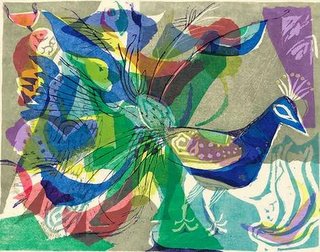Friday, June 23, 2006
How To Get a Little Tail

.
.
.
.
.
.
.
.
.
.
. .
..
.
Does creating art improve your chances of getting laid?
That is the provocative question posed by the article "Peacock's tail fans our flames" by Simon Caterson. More mundanely, the article is reporting on . . . more accurately, attacking . . . a "growing academic movement that is trying to apply Darwinian principles to the study of art and literature." Specifically, New Zealand-based philosopher Denis Dutton has argued in a recent article that the arts "echo the sexual display that accompanies Darwinian selection":
If what Dutton is saying is true, then the famous claim by the French artist Renoir that he painted with his penis is not some idle macho boast but a profoundly knowledgeable and serious aesthetic statement.
Predictably, "[n]ot everyone is convinced that evolutionary theory can be applied so readily to the arts." John Armstrong, who teaches philosophy at the University of Melbourne "points out that the Darwinian explanation of art has the same shortcomings as the theory of natural selection itself."
It is actually very hard to trace the explanatory links between humanity evolving by chance due to the laws of physics and what that tells us about our personal lives or our system of values. ...
We can see that there are these kinds of display for attracting a mate, but these are unconscious and not instrumental. There are also a lot of impostors in the animal world, and it is true that you can easily impress stupid people with a display like that of a rock star strutting on the stage and meeting groupies afterwards. ...
All Darwin tells us is what succeeds. One thing that is very distinctive about human beings is that we care about what things ought to succeed not just what does succeed. Once you introduce that move, then we are beginning to shape our conscious choices and the way we live our lives. We're shaping the patterns of success and failure. ...
The idea that at an individual level the artist is trying to reproduce by creating art is hopeless. It is an occult fantasy. What is totally wrong with the populist Darwinian picture is that things are trying to do anything. Fish are not trying to become land creatures and do not want to pass on their genes. All that evolutionary theory records is that the DNA got transmitted. It has no bearing on motivation.
While I have a certain sympathy for that argument and against the strong adaptionist program, Armstrong (and Caterson, who is clearly on Armstrong's side) cannot help overstating their objection, trotting out the strawman of "Darwinism" and proclaiming it "a substitute for religious faith." Caterson displays appropriate ignorance of evolutionary theory in support of his imaginary religion:
Human beings overall may be progressing as a species thanks to natural selection, using their brains to become better adapted to their environment, living longer and growing stronger, but if the Darwinian theory of art were correct, art would also be showing a gradual but inexorable improvement. This is where the analogy fails. The history of art, unlike human evolution, is not a grand narrative of progress.
Having built his argument on this heap of sand, nothing much following in Mr. Caterson's article makes any sense. Too bad, because it has the seeds of an interesting discussion.
<< Home




